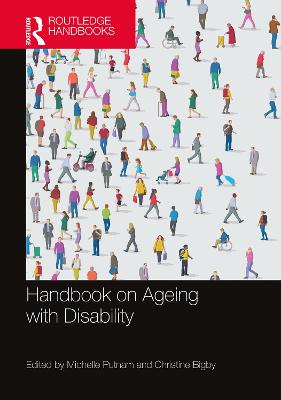Routledge Companion to Rehabilitative Work in Criminal Justice
 -10%
portes grátis
-10%
portes grátis
Routledge Companion to Rehabilitative Work in Criminal Justice
Trotter, Chris; Raynor, Peter; Graham, Hannah; Taxman, Faye S.; Ugwudike, Pamela; McNeill, Fergus
Taylor & Francis Ltd
09/2019
1232
Dura
Inglês
9781138102057
15 a 20 dias
2592
Descrição não disponível.
1. An Introduction to The Routledge Companion to Rehabilitative Work in Criminal Justice; SECTION ONE: THEORIES AND MODELS FOR WORKING WITH OFFENDERS; 2. Conceptualising Rehabilitation: Four forms, two models, one process and a plethora of challenges; 3. Promoting inclusion and citizenship? Selective reflections on the recent history of the policy and practice of rehabilitation in England and Wales; 4. Should there be a right to rehabilitation?; 5. Human Rights and Rehabilitative Work in Criminal Justice; 6. Retribution and Rehabilitation: Taking Punishment Seriously in a Humane Society; 7. Restorative Justice: A different approach to working with offenders and with those whom they have harmed; 8. The Evidence-based Approach to Correctional Rehabilitation: Current status of the Risk-Need-Responsivity (RNR) Model of Offender Rehabilitation; 9. An overview of the Good Lives Model: Theory and evidence; 10. Diversifying desistance research; 11. Doing justice to desistance narratives
12. Therapeutic jurisprudence and rehabilitation; SECTION TWO: POLICY CONTEXTS AND CULTURES; 13. The 'Transforming Rehabilitation' agenda in England and Wales: implications of privatisation; 14. The Rehabilitative Prison: an oxymoron, or an opportunity to radically reform the way we do punishment?; 15. Rehabilitation and re-entry in Scandinavia; 16. Using technology and digitally enabled approaches to support desistance; 17. Prisons, personal development and austerity; SECTION THREE: ASSESSMENT PRACTICE; Chapter 18. Risk and need assessment: Development, critics and a realist approach; 19. A critical review of risk assessment policy and practice since the 1990s; 20. The promises and perils of gender-responsivity: Risk, incarceration, and rehabilitation; 21. Risk and need assessment in youth justice: key challenges; 22. Pre-sentence reports: constructing the subject of punishment and rehabilitation; SECTION FOUR: DIRECT WORK WITH OFFENDERS; 23. Examining community supervision officers' skills and behaviours: A review of strategies for identifying the inner-workings of face-to-face supervision sessions; 24. Motivational Interviewing: Application to Practice in a Probation Context; 25. Trauma-informed practices with youth in criminal justice settings; 26. Building social capital to encourage desistance: Lessons from a veteran-specific project; 27. Working with veterans and addressing Post-Traumatic Stress Disorder; 28. Prosocial Modelling; 29. Core Correctional Practices: The Role of the Working Alliance in Offender Rehabilitation; 30. Gut Check: Turning Experience into Knowledge; 31. Applications of Psychotherapy in Statutory Domestic Violence Perpetrator Programmes: Challenging the Dominance of Cognitive Behavioural Models; 32. Arts-based interventions in the justice system; 33. The use of sport to promote desistance from crime: lessons from across the prison estate; 34. Violent Offenders: Contemporary issues in Risk Assessment, Treatment and Management; 35. Effective approaches to working with sex offenders; 36. 'Five-minute interventions' in prison: rehabilitative conversations with offenders; 37. The benefits of mindfulness-based interventions in the criminal justice system: a review of the evidence; 38. Mentoring in the Justice System; 39. The contribution of ex-service users: An Analysis of the Life and Death of a Peer Mentor Employment Rehabilitation Programme; 40. Co-producing outcomes with service users in the penal system; 41. Victim-focused Work with offenders; SECTION FIVE: RESETTLEMENT; Chapter 42. Preparing prisoners for release: Current and recurrent challenges; 43. Prisoner Reentry in the United States; 44. Post-release residential supervision; 45. The Health Needs of People Leaving Prison: A New Horizon to Address; Chapter 46. Rights, Advocacy and Transformation; 47. Strengths-Based Reentry and Resettlement; 48. The Role of Third Sector Organisations in Supporting Resettlement and Reintegration; SECTION SIX: APPLICATION TO SPECIFIC GROUPS; 49. More Sinned against than Sinning: Women's pathways into crime and criminalisation; 50. What Works with Female Offenders? A UK Perspective; 51. Gender-Responsive Approaches for Women in the United States; 52. Women's experiences of the criminal justice system; 53. Working with Black and Minority Ethnic Groups in the Penal System; 54. 'Race', Rehabilitation and Offender Management; 55. Hamlet's Dilemma: Racialization, agency, and the barriers to black men's desistance; 56. Applications of risk prediction technologies in criminal justice: The nexus of race and digitised control; 57. Cultural competency in community corrections; 58. Responding to youth offending: historical and current developments in practice; 59. Youth Justice in Wales; 60. 'Rights-Based' and 'Children and Young People First' Approaches to Youth Justice; 61. Effective supervision of young offenders; 62. Working with young people in prison; 63 Prevention Work with Young People; 64. Realising the potential of community reparation for young offenders; 65. Foreign national prisoners: Precarity and deportability as obstacles to rehabilitation; 66. End of life in prison: challenges for prisons, staff and prisoners; 67. Older Prisoners: A Challenge for Correctional Services; 68. The role of offenders' family links in offender rehabilitation; 69. The Impact of Imprisonment on Families; SECTION SEVEN: SECTION SEVEN: CONTROL AND SURVEILLANCE; 70. Approaches to working with young people: encouraging compliance; 71. Compliance during community-based penal supervision; 72. The Impact of adjudications and discipline; 73. Electronic monitoring and rehabilitation; 74. Integrated offender management and rehabilitation for adult offenders in England and Wales; SECTION EIGHT: THE MANY HATS OF PROBATION: PRACTICE ETHOS AND PRACTITIONERS' PERSPECTIVES; 75. Probation worker identities: responding to change and turbulence in community rehabilitation; 76. Probation values in England and Wales: can they survive Transforming Rehabilitation?; 77. Probation and Parole - Shaping Principles and Practices in the Early 21st Century: A US Perspective; 78. How practitioners conceptualise quality: A UK Perspective; 79. The balancing act of probation supervision: The roles and philosophies of probation officers in the evidence-based practice era; 80. Innovations to transform probation supervision: An examination of experiences across eleven US agencies; SECTION NINE: LIVED EXPERIENCES FROM THE LENS OF INDIVIDUALS INVOLVED IN THE JUSTICE SYSTEM AND PRACTITIONERS; 81. Experiencing community-based supervision: the pains of probation; 82. Experiencing Probation: Results from the Honest Opportunity Probation with Enforcement (HOPE) Demonstration Field Experiment: US Perspective; 83. Pain, Harm and Punishment; SECTION TEN: THE DEVELOPMENT OF AN EVIDENCE BASE; 84. Features of Effective Prison-based Programmes for Reducing Recidivism; 85. Performance Measure in Community Corrections: Measuring Effective Supervision Practices with Existing Agency Data; 86. Visual methods and Probation Practice; 87. Evaluating practice: Observation methods; 88. Evaluating Women's Programmes; 89. Group programmes with offenders; 90. Evaluating Group Programmes: A Question of Design?; 91. The Lost Narrative in Carceral Settings: Evaluative Practices and Methods to Improve Process and Outcomes Within Institutions; 92. Probation research, evidence and policy: the British experience
12. Therapeutic jurisprudence and rehabilitation; SECTION TWO: POLICY CONTEXTS AND CULTURES; 13. The 'Transforming Rehabilitation' agenda in England and Wales: implications of privatisation; 14. The Rehabilitative Prison: an oxymoron, or an opportunity to radically reform the way we do punishment?; 15. Rehabilitation and re-entry in Scandinavia; 16. Using technology and digitally enabled approaches to support desistance; 17. Prisons, personal development and austerity; SECTION THREE: ASSESSMENT PRACTICE; Chapter 18. Risk and need assessment: Development, critics and a realist approach; 19. A critical review of risk assessment policy and practice since the 1990s; 20. The promises and perils of gender-responsivity: Risk, incarceration, and rehabilitation; 21. Risk and need assessment in youth justice: key challenges; 22. Pre-sentence reports: constructing the subject of punishment and rehabilitation; SECTION FOUR: DIRECT WORK WITH OFFENDERS; 23. Examining community supervision officers' skills and behaviours: A review of strategies for identifying the inner-workings of face-to-face supervision sessions; 24. Motivational Interviewing: Application to Practice in a Probation Context; 25. Trauma-informed practices with youth in criminal justice settings; 26. Building social capital to encourage desistance: Lessons from a veteran-specific project; 27. Working with veterans and addressing Post-Traumatic Stress Disorder; 28. Prosocial Modelling; 29. Core Correctional Practices: The Role of the Working Alliance in Offender Rehabilitation; 30. Gut Check: Turning Experience into Knowledge; 31. Applications of Psychotherapy in Statutory Domestic Violence Perpetrator Programmes: Challenging the Dominance of Cognitive Behavioural Models; 32. Arts-based interventions in the justice system; 33. The use of sport to promote desistance from crime: lessons from across the prison estate; 34. Violent Offenders: Contemporary issues in Risk Assessment, Treatment and Management; 35. Effective approaches to working with sex offenders; 36. 'Five-minute interventions' in prison: rehabilitative conversations with offenders; 37. The benefits of mindfulness-based interventions in the criminal justice system: a review of the evidence; 38. Mentoring in the Justice System; 39. The contribution of ex-service users: An Analysis of the Life and Death of a Peer Mentor Employment Rehabilitation Programme; 40. Co-producing outcomes with service users in the penal system; 41. Victim-focused Work with offenders; SECTION FIVE: RESETTLEMENT; Chapter 42. Preparing prisoners for release: Current and recurrent challenges; 43. Prisoner Reentry in the United States; 44. Post-release residential supervision; 45. The Health Needs of People Leaving Prison: A New Horizon to Address; Chapter 46. Rights, Advocacy and Transformation; 47. Strengths-Based Reentry and Resettlement; 48. The Role of Third Sector Organisations in Supporting Resettlement and Reintegration; SECTION SIX: APPLICATION TO SPECIFIC GROUPS; 49. More Sinned against than Sinning: Women's pathways into crime and criminalisation; 50. What Works with Female Offenders? A UK Perspective; 51. Gender-Responsive Approaches for Women in the United States; 52. Women's experiences of the criminal justice system; 53. Working with Black and Minority Ethnic Groups in the Penal System; 54. 'Race', Rehabilitation and Offender Management; 55. Hamlet's Dilemma: Racialization, agency, and the barriers to black men's desistance; 56. Applications of risk prediction technologies in criminal justice: The nexus of race and digitised control; 57. Cultural competency in community corrections; 58. Responding to youth offending: historical and current developments in practice; 59. Youth Justice in Wales; 60. 'Rights-Based' and 'Children and Young People First' Approaches to Youth Justice; 61. Effective supervision of young offenders; 62. Working with young people in prison; 63 Prevention Work with Young People; 64. Realising the potential of community reparation for young offenders; 65. Foreign national prisoners: Precarity and deportability as obstacles to rehabilitation; 66. End of life in prison: challenges for prisons, staff and prisoners; 67. Older Prisoners: A Challenge for Correctional Services; 68. The role of offenders' family links in offender rehabilitation; 69. The Impact of Imprisonment on Families; SECTION SEVEN: SECTION SEVEN: CONTROL AND SURVEILLANCE; 70. Approaches to working with young people: encouraging compliance; 71. Compliance during community-based penal supervision; 72. The Impact of adjudications and discipline; 73. Electronic monitoring and rehabilitation; 74. Integrated offender management and rehabilitation for adult offenders in England and Wales; SECTION EIGHT: THE MANY HATS OF PROBATION: PRACTICE ETHOS AND PRACTITIONERS' PERSPECTIVES; 75. Probation worker identities: responding to change and turbulence in community rehabilitation; 76. Probation values in England and Wales: can they survive Transforming Rehabilitation?; 77. Probation and Parole - Shaping Principles and Practices in the Early 21st Century: A US Perspective; 78. How practitioners conceptualise quality: A UK Perspective; 79. The balancing act of probation supervision: The roles and philosophies of probation officers in the evidence-based practice era; 80. Innovations to transform probation supervision: An examination of experiences across eleven US agencies; SECTION NINE: LIVED EXPERIENCES FROM THE LENS OF INDIVIDUALS INVOLVED IN THE JUSTICE SYSTEM AND PRACTITIONERS; 81. Experiencing community-based supervision: the pains of probation; 82. Experiencing Probation: Results from the Honest Opportunity Probation with Enforcement (HOPE) Demonstration Field Experiment: US Perspective; 83. Pain, Harm and Punishment; SECTION TEN: THE DEVELOPMENT OF AN EVIDENCE BASE; 84. Features of Effective Prison-based Programmes for Reducing Recidivism; 85. Performance Measure in Community Corrections: Measuring Effective Supervision Practices with Existing Agency Data; 86. Visual methods and Probation Practice; 87. Evaluating practice: Observation methods; 88. Evaluating Women's Programmes; 89. Group programmes with offenders; 90. Evaluating Group Programmes: A Question of Design?; 91. The Lost Narrative in Carceral Settings: Evaluative Practices and Methods to Improve Process and Outcomes Within Institutions; 92. Probation research, evidence and policy: the British experience
Este título pertence ao(s) assunto(s) indicados(s). Para ver outros títulos clique no assunto desejado.
Young Men;Rehabilitation;Correctional Program Assessment Inventory;Desistance;Good Lives Model;Therapeutic jurisprudence;RNR Model;Transforming Rehabilitation;BAME People;Reentry;Good Lives;Community Corrections;Community Rehabilitation Companies;Risk assessment;Time Entrants;Offender supervision;Vice Versa;Offender management;Evidence Based Practice Skills;Diversion;Hm Inspectorate;Electronic monitoring;Rehabilitative Work;Public Protection;Core Correctional Practices;Female Offenders;Youth Justice;Youth Offending;National Probation Service;Mentally Disordered Offenders;Youth Justice System;Evidence-based practice;Effective Practice Skills;criminal justice policy;Community Supervision Officers;criminal justice systems;Primary Human Good;criminal offences;Hm Prison;correctional rehabilitation;Desistance Processes;Probation Workers;Pro-social Modelling;BAME Service User;RFPP
1. An Introduction to The Routledge Companion to Rehabilitative Work in Criminal Justice; SECTION ONE: THEORIES AND MODELS FOR WORKING WITH OFFENDERS; 2. Conceptualising Rehabilitation: Four forms, two models, one process and a plethora of challenges; 3. Promoting inclusion and citizenship? Selective reflections on the recent history of the policy and practice of rehabilitation in England and Wales; 4. Should there be a right to rehabilitation?; 5. Human Rights and Rehabilitative Work in Criminal Justice; 6. Retribution and Rehabilitation: Taking Punishment Seriously in a Humane Society; 7. Restorative Justice: A different approach to working with offenders and with those whom they have harmed; 8. The Evidence-based Approach to Correctional Rehabilitation: Current status of the Risk-Need-Responsivity (RNR) Model of Offender Rehabilitation; 9. An overview of the Good Lives Model: Theory and evidence; 10. Diversifying desistance research; 11. Doing justice to desistance narratives
12. Therapeutic jurisprudence and rehabilitation; SECTION TWO: POLICY CONTEXTS AND CULTURES; 13. The 'Transforming Rehabilitation' agenda in England and Wales: implications of privatisation; 14. The Rehabilitative Prison: an oxymoron, or an opportunity to radically reform the way we do punishment?; 15. Rehabilitation and re-entry in Scandinavia; 16. Using technology and digitally enabled approaches to support desistance; 17. Prisons, personal development and austerity; SECTION THREE: ASSESSMENT PRACTICE; Chapter 18. Risk and need assessment: Development, critics and a realist approach; 19. A critical review of risk assessment policy and practice since the 1990s; 20. The promises and perils of gender-responsivity: Risk, incarceration, and rehabilitation; 21. Risk and need assessment in youth justice: key challenges; 22. Pre-sentence reports: constructing the subject of punishment and rehabilitation; SECTION FOUR: DIRECT WORK WITH OFFENDERS; 23. Examining community supervision officers' skills and behaviours: A review of strategies for identifying the inner-workings of face-to-face supervision sessions; 24. Motivational Interviewing: Application to Practice in a Probation Context; 25. Trauma-informed practices with youth in criminal justice settings; 26. Building social capital to encourage desistance: Lessons from a veteran-specific project; 27. Working with veterans and addressing Post-Traumatic Stress Disorder; 28. Prosocial Modelling; 29. Core Correctional Practices: The Role of the Working Alliance in Offender Rehabilitation; 30. Gut Check: Turning Experience into Knowledge; 31. Applications of Psychotherapy in Statutory Domestic Violence Perpetrator Programmes: Challenging the Dominance of Cognitive Behavioural Models; 32. Arts-based interventions in the justice system; 33. The use of sport to promote desistance from crime: lessons from across the prison estate; 34. Violent Offenders: Contemporary issues in Risk Assessment, Treatment and Management; 35. Effective approaches to working with sex offenders; 36. 'Five-minute interventions' in prison: rehabilitative conversations with offenders; 37. The benefits of mindfulness-based interventions in the criminal justice system: a review of the evidence; 38. Mentoring in the Justice System; 39. The contribution of ex-service users: An Analysis of the Life and Death of a Peer Mentor Employment Rehabilitation Programme; 40. Co-producing outcomes with service users in the penal system; 41. Victim-focused Work with offenders; SECTION FIVE: RESETTLEMENT; Chapter 42. Preparing prisoners for release: Current and recurrent challenges; 43. Prisoner Reentry in the United States; 44. Post-release residential supervision; 45. The Health Needs of People Leaving Prison: A New Horizon to Address; Chapter 46. Rights, Advocacy and Transformation; 47. Strengths-Based Reentry and Resettlement; 48. The Role of Third Sector Organisations in Supporting Resettlement and Reintegration; SECTION SIX: APPLICATION TO SPECIFIC GROUPS; 49. More Sinned against than Sinning: Women's pathways into crime and criminalisation; 50. What Works with Female Offenders? A UK Perspective; 51. Gender-Responsive Approaches for Women in the United States; 52. Women's experiences of the criminal justice system; 53. Working with Black and Minority Ethnic Groups in the Penal System; 54. 'Race', Rehabilitation and Offender Management; 55. Hamlet's Dilemma: Racialization, agency, and the barriers to black men's desistance; 56. Applications of risk prediction technologies in criminal justice: The nexus of race and digitised control; 57. Cultural competency in community corrections; 58. Responding to youth offending: historical and current developments in practice; 59. Youth Justice in Wales; 60. 'Rights-Based' and 'Children and Young People First' Approaches to Youth Justice; 61. Effective supervision of young offenders; 62. Working with young people in prison; 63 Prevention Work with Young People; 64. Realising the potential of community reparation for young offenders; 65. Foreign national prisoners: Precarity and deportability as obstacles to rehabilitation; 66. End of life in prison: challenges for prisons, staff and prisoners; 67. Older Prisoners: A Challenge for Correctional Services; 68. The role of offenders' family links in offender rehabilitation; 69. The Impact of Imprisonment on Families; SECTION SEVEN: SECTION SEVEN: CONTROL AND SURVEILLANCE; 70. Approaches to working with young people: encouraging compliance; 71. Compliance during community-based penal supervision; 72. The Impact of adjudications and discipline; 73. Electronic monitoring and rehabilitation; 74. Integrated offender management and rehabilitation for adult offenders in England and Wales; SECTION EIGHT: THE MANY HATS OF PROBATION: PRACTICE ETHOS AND PRACTITIONERS' PERSPECTIVES; 75. Probation worker identities: responding to change and turbulence in community rehabilitation; 76. Probation values in England and Wales: can they survive Transforming Rehabilitation?; 77. Probation and Parole - Shaping Principles and Practices in the Early 21st Century: A US Perspective; 78. How practitioners conceptualise quality: A UK Perspective; 79. The balancing act of probation supervision: The roles and philosophies of probation officers in the evidence-based practice era; 80. Innovations to transform probation supervision: An examination of experiences across eleven US agencies; SECTION NINE: LIVED EXPERIENCES FROM THE LENS OF INDIVIDUALS INVOLVED IN THE JUSTICE SYSTEM AND PRACTITIONERS; 81. Experiencing community-based supervision: the pains of probation; 82. Experiencing Probation: Results from the Honest Opportunity Probation with Enforcement (HOPE) Demonstration Field Experiment: US Perspective; 83. Pain, Harm and Punishment; SECTION TEN: THE DEVELOPMENT OF AN EVIDENCE BASE; 84. Features of Effective Prison-based Programmes for Reducing Recidivism; 85. Performance Measure in Community Corrections: Measuring Effective Supervision Practices with Existing Agency Data; 86. Visual methods and Probation Practice; 87. Evaluating practice: Observation methods; 88. Evaluating Women's Programmes; 89. Group programmes with offenders; 90. Evaluating Group Programmes: A Question of Design?; 91. The Lost Narrative in Carceral Settings: Evaluative Practices and Methods to Improve Process and Outcomes Within Institutions; 92. Probation research, evidence and policy: the British experience
12. Therapeutic jurisprudence and rehabilitation; SECTION TWO: POLICY CONTEXTS AND CULTURES; 13. The 'Transforming Rehabilitation' agenda in England and Wales: implications of privatisation; 14. The Rehabilitative Prison: an oxymoron, or an opportunity to radically reform the way we do punishment?; 15. Rehabilitation and re-entry in Scandinavia; 16. Using technology and digitally enabled approaches to support desistance; 17. Prisons, personal development and austerity; SECTION THREE: ASSESSMENT PRACTICE; Chapter 18. Risk and need assessment: Development, critics and a realist approach; 19. A critical review of risk assessment policy and practice since the 1990s; 20. The promises and perils of gender-responsivity: Risk, incarceration, and rehabilitation; 21. Risk and need assessment in youth justice: key challenges; 22. Pre-sentence reports: constructing the subject of punishment and rehabilitation; SECTION FOUR: DIRECT WORK WITH OFFENDERS; 23. Examining community supervision officers' skills and behaviours: A review of strategies for identifying the inner-workings of face-to-face supervision sessions; 24. Motivational Interviewing: Application to Practice in a Probation Context; 25. Trauma-informed practices with youth in criminal justice settings; 26. Building social capital to encourage desistance: Lessons from a veteran-specific project; 27. Working with veterans and addressing Post-Traumatic Stress Disorder; 28. Prosocial Modelling; 29. Core Correctional Practices: The Role of the Working Alliance in Offender Rehabilitation; 30. Gut Check: Turning Experience into Knowledge; 31. Applications of Psychotherapy in Statutory Domestic Violence Perpetrator Programmes: Challenging the Dominance of Cognitive Behavioural Models; 32. Arts-based interventions in the justice system; 33. The use of sport to promote desistance from crime: lessons from across the prison estate; 34. Violent Offenders: Contemporary issues in Risk Assessment, Treatment and Management; 35. Effective approaches to working with sex offenders; 36. 'Five-minute interventions' in prison: rehabilitative conversations with offenders; 37. The benefits of mindfulness-based interventions in the criminal justice system: a review of the evidence; 38. Mentoring in the Justice System; 39. The contribution of ex-service users: An Analysis of the Life and Death of a Peer Mentor Employment Rehabilitation Programme; 40. Co-producing outcomes with service users in the penal system; 41. Victim-focused Work with offenders; SECTION FIVE: RESETTLEMENT; Chapter 42. Preparing prisoners for release: Current and recurrent challenges; 43. Prisoner Reentry in the United States; 44. Post-release residential supervision; 45. The Health Needs of People Leaving Prison: A New Horizon to Address; Chapter 46. Rights, Advocacy and Transformation; 47. Strengths-Based Reentry and Resettlement; 48. The Role of Third Sector Organisations in Supporting Resettlement and Reintegration; SECTION SIX: APPLICATION TO SPECIFIC GROUPS; 49. More Sinned against than Sinning: Women's pathways into crime and criminalisation; 50. What Works with Female Offenders? A UK Perspective; 51. Gender-Responsive Approaches for Women in the United States; 52. Women's experiences of the criminal justice system; 53. Working with Black and Minority Ethnic Groups in the Penal System; 54. 'Race', Rehabilitation and Offender Management; 55. Hamlet's Dilemma: Racialization, agency, and the barriers to black men's desistance; 56. Applications of risk prediction technologies in criminal justice: The nexus of race and digitised control; 57. Cultural competency in community corrections; 58. Responding to youth offending: historical and current developments in practice; 59. Youth Justice in Wales; 60. 'Rights-Based' and 'Children and Young People First' Approaches to Youth Justice; 61. Effective supervision of young offenders; 62. Working with young people in prison; 63 Prevention Work with Young People; 64. Realising the potential of community reparation for young offenders; 65. Foreign national prisoners: Precarity and deportability as obstacles to rehabilitation; 66. End of life in prison: challenges for prisons, staff and prisoners; 67. Older Prisoners: A Challenge for Correctional Services; 68. The role of offenders' family links in offender rehabilitation; 69. The Impact of Imprisonment on Families; SECTION SEVEN: SECTION SEVEN: CONTROL AND SURVEILLANCE; 70. Approaches to working with young people: encouraging compliance; 71. Compliance during community-based penal supervision; 72. The Impact of adjudications and discipline; 73. Electronic monitoring and rehabilitation; 74. Integrated offender management and rehabilitation for adult offenders in England and Wales; SECTION EIGHT: THE MANY HATS OF PROBATION: PRACTICE ETHOS AND PRACTITIONERS' PERSPECTIVES; 75. Probation worker identities: responding to change and turbulence in community rehabilitation; 76. Probation values in England and Wales: can they survive Transforming Rehabilitation?; 77. Probation and Parole - Shaping Principles and Practices in the Early 21st Century: A US Perspective; 78. How practitioners conceptualise quality: A UK Perspective; 79. The balancing act of probation supervision: The roles and philosophies of probation officers in the evidence-based practice era; 80. Innovations to transform probation supervision: An examination of experiences across eleven US agencies; SECTION NINE: LIVED EXPERIENCES FROM THE LENS OF INDIVIDUALS INVOLVED IN THE JUSTICE SYSTEM AND PRACTITIONERS; 81. Experiencing community-based supervision: the pains of probation; 82. Experiencing Probation: Results from the Honest Opportunity Probation with Enforcement (HOPE) Demonstration Field Experiment: US Perspective; 83. Pain, Harm and Punishment; SECTION TEN: THE DEVELOPMENT OF AN EVIDENCE BASE; 84. Features of Effective Prison-based Programmes for Reducing Recidivism; 85. Performance Measure in Community Corrections: Measuring Effective Supervision Practices with Existing Agency Data; 86. Visual methods and Probation Practice; 87. Evaluating practice: Observation methods; 88. Evaluating Women's Programmes; 89. Group programmes with offenders; 90. Evaluating Group Programmes: A Question of Design?; 91. The Lost Narrative in Carceral Settings: Evaluative Practices and Methods to Improve Process and Outcomes Within Institutions; 92. Probation research, evidence and policy: the British experience
Este título pertence ao(s) assunto(s) indicados(s). Para ver outros títulos clique no assunto desejado.
Young Men;Rehabilitation;Correctional Program Assessment Inventory;Desistance;Good Lives Model;Therapeutic jurisprudence;RNR Model;Transforming Rehabilitation;BAME People;Reentry;Good Lives;Community Corrections;Community Rehabilitation Companies;Risk assessment;Time Entrants;Offender supervision;Vice Versa;Offender management;Evidence Based Practice Skills;Diversion;Hm Inspectorate;Electronic monitoring;Rehabilitative Work;Public Protection;Core Correctional Practices;Female Offenders;Youth Justice;Youth Offending;National Probation Service;Mentally Disordered Offenders;Youth Justice System;Evidence-based practice;Effective Practice Skills;criminal justice policy;Community Supervision Officers;criminal justice systems;Primary Human Good;criminal offences;Hm Prison;correctional rehabilitation;Desistance Processes;Probation Workers;Pro-social Modelling;BAME Service User;RFPP







